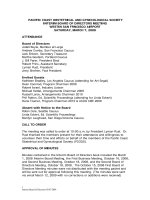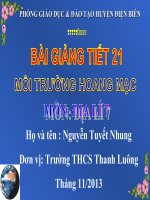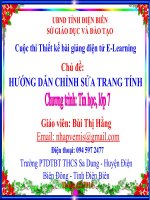Slide semantic meeting 7
Bạn đang xem bản rút gọn của tài liệu. Xem và tải ngay bản đầy đủ của tài liệu tại đây (84.03 KB, 17 trang )
Semantics 1
Meeting 7
Section1: Word Meaning
2.12 Homonymy
EX1: I go to the bank (1) to loan money
a financial institution
EX2: She often sits at the bank (2) of the river in her hometown
the shore of a river
bank (1) & (2): same sounds? + same written forms?
+ different meanings? = homonyms
Homonymy is a relation in which various words have the
same ( sound and written) forms but have different
meanings.
Section1: Word Meaning
2.12.1 Homophony
EX3: hour = a twenty-four part of a day and night
our = belonging to us
/‘auә(r)/
“hour” & “our” : same sounds? + different meanings?
+ different written forms? = homophones
Homophony is a relation in which various words have
the same sound form but have different meanings and
written forms.
Section1: Word Meaning
2.12.2 Homography
EX4: Does this road lead to town?
/li:d/ (v)
EX5: Lead is a heavy metal
/led/ (n)
lead (v) & lead (n): different sounds? + same written
forms?
+ different meanings? = homographs
Homography is a relation in which various words have
the same written form but have different meanings and
sound forms.
Section1: Word Meaning
+ : the same
- : different
Written form
Sound form
Meaning
Antonymy
-
-
-
Synonymy
-
-
+
Homonymy
+
+
-
Homophony
-
+
-
Homography
+
-
-
Exercise 17,p.75-76
1. altar
/ ‘Ɔ:ltә(r)/
alter
3. boar
bore
/bƆ: (r)/
2. beech
/ bi:tʃ/
beach
4. coarse
/ kƆ:s/
course
5. crews
/ kru:z/
cruise
6. deer
dear
/ diә(r) /
7. draft
/ dra:ft/
draught
8. fare
fair
/ feә(r)/
9. flour
/ ‘flaטә(r) /
flower
10. grate
great
/ greit /
Exercise 17,p.75-76
11. herd
/ hз:d/
heard
12. knight
night
/ nai:t/
13. nose
/nәטz/
knows
14. leek
leak
/ li:k/
15. maid
/ meid/
made
16. pail
pale
/ peil /
17. reign
rain
18. scene
seen
/ si:n/
20. whole
hole
/ hәטl/
/ rein/
19.
thrown / θrәטn /
throne
Exercise 18,p.76-77
1. lie (1) = tell lies
/ lai /
lie (2) = put one’s body on a horizontal
surface
2. bat (1) = the small mouse-like animal that flies at night
and feeds on fruit and insects
/ bæt/
bat (2) = a tool for hitting in baseball
3. too (1) = more than it should be
too (2) = also
/ tu:/
4. might (n) = great strength or power
might (v) = possibility
/ mait/
Exercise 18,p.76-77
5. bare (a) = without the usual covering or protection
/ beә(r) /
bare (v) = uncover or reveal (something)
6. sound (n) = things can be heard
sound (a) = healthy or in good condition
/ saטnd/
7. lead (v) = Does this road lead to town?
lead (n) = He’s the chief trouble-maker
The others just follow his lead
/ li:d/
Exercise 19,p.77-78
1. true - false binary antonymy
8. pupil = at a school
2. gloom - darknesssynonymy
homonymy
pupil = of an eye
3. dark = a dark room
polysemy
dark = don’t look on the dark side of things
4. wind = The wind is blowing hard
homography
wind = wind one’s watch
9. cheap - expensive
5. deny - admit binary antonymy
gradable antonymy
6. host - guest
relational antonymy
10. coarse - course
7. sow = sow a field with wheat
homophony
homography
sow = a female pig
Section1: Word Meaning
2.13 Polysemy
EX6: chip (n): a small piece of some hard substance which has been
broken off from something larger: a chip of wood/glass
a small cut piece of potato which is fried
for eating: Can I try one of your chips?
a small but vital piece of a computer: this computer
has got a faster chip than the old one.
03 meanings = related together = small piece?
chip = a polesymous word
Polysemy is a relation in which a single word has two or
more slightly different but closely related meanings.
Section1: Word Meaning
* How to distinguish polysemy and homonymy?
EX7: I go to the bank (1) /bæŋk/ to loan money
EX8: She often sits at the bank (2) /bæŋk/ of the river in her hometown
bank (1) & bank (2) = same written form?
= same sound form?
= completely different meanings?
= 02 meanings/not related?
homonyms
Section1: Word Meaning
* How to distinguish polysemy and homonymy?
EX9: chip (n): a small piece of some hard substance which has been
broken off from something larger: a chip of wood/glass
a small cut piece of potato which is fried
for eating: Can I try one of your chips?
a small but vital piece of a computer: this computer
has got a faster chip than the old one.
03 meanings of “chip” = same written form?
= same sound form?
= slightly different meanings?
= 03 meanings/related?
polysemy
Section1: Word Meaning
* How to distinguish polysemy and homonymy?
1/ Do words from a polysemous word have the same spellings?
2/ Do homonyms have the same spellings?
3/ Can we use spelling to distinguish a polysemy and homonymy?
Section1: Word Meaning
* How to distinguish polysemy and homonymy?
bank (1) = financial institute (derive from Anglo-Saxon roots)
bank (2) = shore of river ( has a Scandinavian origin)
Do bank (1) and bank (2) have the same origin of words?
Therefore, words with the different origins often are homonyms
What about polysemous words, do they have the same origin?
In contrast, words with the same origin often are polysemy
Can we use the origins of words (ETYMOLOGY) to
distinguish polysemy and homonymy?
Section1: Word Meaning
* How to distinguish polysemy and homonymy?
Ex10. plain (a) = clear or easy
= undecorated
= simple (a)
# complex (a)
plain = a polysemous word
Ex11. sound (n) = things can be heard
sound (a) = healthy or in good condition
* Can you find any antonyms or synonyms for “sound” (n) and “ sound” (a)?
So, “sound” (n) and “ sound” (a) are two homonyms
* Can you use antonyms and synonyms to distinguish polysemy and
homonymy?
Section1: Word Meaning
* How to distinguish polysemy and homonymy?
Ex11. plain (a) = clear or easy (1)
= undecorated (2)
meaning (1) & meaning (2): related, both mean no complexity.
So, plain = a polysemous word
Ex12. sound (n) = things can be heard (1)
sound (a) = healthy or in good condition (2)
Meaning (1) & meaning (2): unrelated meanings
So, “sound” (n) and “ sound” (v) are two homonyms
* Can you use commonality to distinguish polysemy and homonymy?









